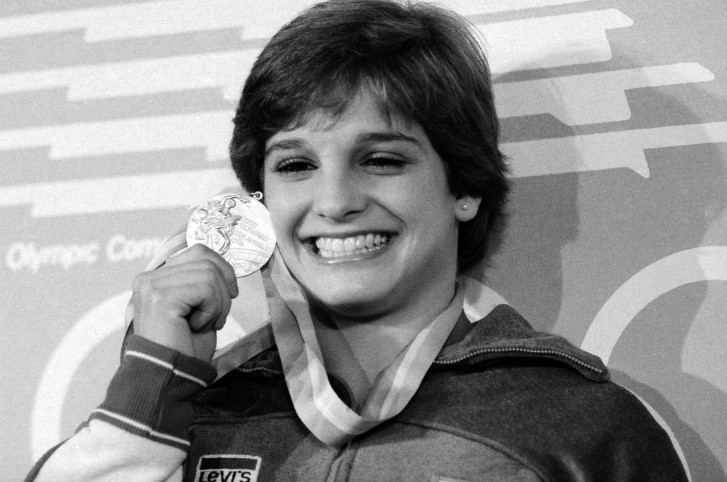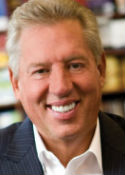 Thirty years ago, Mary Lou Retton vaulted into stardom at the 1984 Olympic Games, becoming the first American to win gold in the women’s all-around gymnastics competition. She wowed the world with her amazing mix of grace, power, and dexterity. Her Olympic triumph, combined with her buoyant, bubbly personality made her an instant media sensation.
Thirty years ago, Mary Lou Retton vaulted into stardom at the 1984 Olympic Games, becoming the first American to win gold in the women’s all-around gymnastics competition. She wowed the world with her amazing mix of grace, power, and dexterity. Her Olympic triumph, combined with her buoyant, bubbly personality made her an instant media sensation.
The speed with which Retton attained celebrity masked the years of sacrifice, dedication, and determined effort during which the little girl from West Virginia had developed into a world-class athlete. In the words of Sports Illustrated writer Frank Deford, May Lou Retton had “worked a lifetime to become a darling overnight.” Her Olympic victory had come at a tremendous cost. It caused her to move halfway across the country from her parents, required her to miss our on a normal childhood, and exacted a significant toll on her body.
Mary Lou Retton’s dream took shape when she was eight years old. Glued to the television set, the young girl watched in awe as Romanian gymnast, Nadia Comaneci, won gold at the 1976 Olympics. Inspired by the performance, Retton practiced the splits in her living room and declared, “I’m going to go to the Olympics one day. I’m going to win the Olympics!”
Over the next few years, the energetic Retton excelled at gymnastics, winning several local meets. It became apparent that she had special talent, but the training options in her hometown were limited. To go to the next level, Retton knew she needed professional coaching. She begged her parents to let her train with Bela Karolyi, the man who had taught her role model, Nadia Comaneci. At first her parents refused, believing their daughter—only 13—was too young to move Karolyi’s training facility in Houston. Yet, Retton continued to plead for the opportunity, and after a year, her parents relented. They scraped together the funds to send their daughter to Texas.
Barely a teenager, Retton experienced intense homesickness upon arrival to Houston, but the separation from her parents was “all worth it. If I hadn’t gone, I would never be where I am today.” Despite missing her family, Retton quickly settled into her new life of rigorous training. She went to the gym from 7:00 to 11:00 in the morning, spent the afternoon taking educational courses by correspondence, and then returned to the gym from 5:00 to 9:00 at night. She kept up the demanding regimen for two years. “You give up your childhood,” Retton said of the experience. “You miss proms and games and high school events, and people say it’s awful… but I say it was a good trade. You miss something, but I think I gained more than I lost.”
Through the constant leaping and bounding of gymnastics, the body takes a pounding. Even as teenagers, gymnasts feel arthritic symptoms and suffer all manner of aches and pains in their joints. As a 15-year old, Retton missed the World Championships with a wrist injury. Six months prior to the Olympics in 1984 she suffered a knee injury that put her participation in jeopardy. She underwent arthroscopic surgery and then “did three months of rehabilitation in two weeks” to get herself back on track. Long after her career was over, Retton was still paying the price physically: she needed a hip replacement before her 40th birthday.
Looking back on her life, Mary Lou Retton acknowledges that the sacrifices she made along the way were incredible—not only for herself but for her family. But she knows every one of them was worth the pain. “I view sacrifice as a kind of ‘moral investment,’ where what you give up now in the way of immediate gratification will eventually pay you tremendous dividends down the line.”
Thought to Ponder
The dream is free, but the journey isn’t. At some point, you have to make a transition from believer of the dream to buyer of the dream. No dream comes true without somebody paying for it. If you want to achieve the dream, you have to be willing to do more than just imagine the outcome. You have to sacrifice your comfort, money, time, and energy. Over the next year, what sacrifices do you anticipate needing to make in order to move closer to your dream?
John Maxwell grew up in the 1950s in the small Midwestern city of Circleville, Ohio. John's earliest childhood memory is of knowing that he would someday be a pastor. He professed faith in Christ at the age of three, and reaffirmed that commitment when he was 13. At age 17, John began preparing for the ministry. He attended Circleville Bible College, earning his bachelor's degree in 1969. In June of that same year, he married his sweetheart, Margaret, and moved to tiny Hillham, Indiana, where he began his first pastorate.
While serving in his second church, Maxwell began to study the correlation between leadership effectiveness and ministry effectiveness. On July 4, 1976, while preaching at a service commemorating America's bicentennial, John sensed that God was calling him into a ministry to pastors. Within days after that event, pastors began to contact him, asking for his assistance in nurturing their churches. Over the next four years, on an informal basis, John helped scores of fellow pastors. Then, in 1980, he was asked to become Executive Director of Evangelism for the Wesleyan denomination.
Though his time at Wesleyan headquarters was productive, John soon realized that his deeper desire was to help pastors from numerous denominations. He knew that desire would be unfulfilled if he were to stay at denominational headquarters. As a result, in 1981 John accepted the call to return to the pastorate, this time at Skyline Wesleyan Church in the San Diego, California area. But he did so with the church's blessing to pursue his vision. The Skyline congregation allowed him to continue mentoring and assisting pastors even as he led them to new levels.
In 1985, as he continued to equip and encourage other pastors, John took the next crucial step in leadership development. He founded a new company called INJOY and created the INJOY Life Club, featuring a monthly tape for leaders. The fledging operation, established in the corner of a garage, was soon bursting at the seams. The INJOY Life Club tapes were received with great enthusiasm, and the number of subscriptions quickly increased from hundreds to thousands. Simultaneously, the demand for other resources and seminars exploded. Pastors from coast to coast were responding, and their desire for help was even greater than John had anticipated.
As the years passed, INJOY began demanding more and more of John's time. In 1995, he resigned from his position as senior pastor at Skyline following a very fruitful 14-year tenure. The church had tripled in size and its lay ministry involvement had increased ten-fold. Dr. Maxwell is in great demand today as a speaker. Through his bestselling books, audio and video resources, and major conferences, he communicates directly with more than one million people every year. He is frequently asked to speak for organizations such as Promise Keepers and Focus on the Family, but his greatest joy and desire is to help pastors become better leaders.
Because the need for leadership development knows no borders, John established EQUIP, a non-profit organization which trains leaders in urban communities, academic institutions, and within international organizations. EQUIP is also spearheading a movement which has enlisted more than one million pastoral prayer partners who covenant to pray specifically for those who shepherd God's flock.
John continues to seek new opportunities to help churches and church leaders. He knows that one thing is constant: the only hope for the world is salvation through the Lord Jesus Christ, who gives life abundantly.

